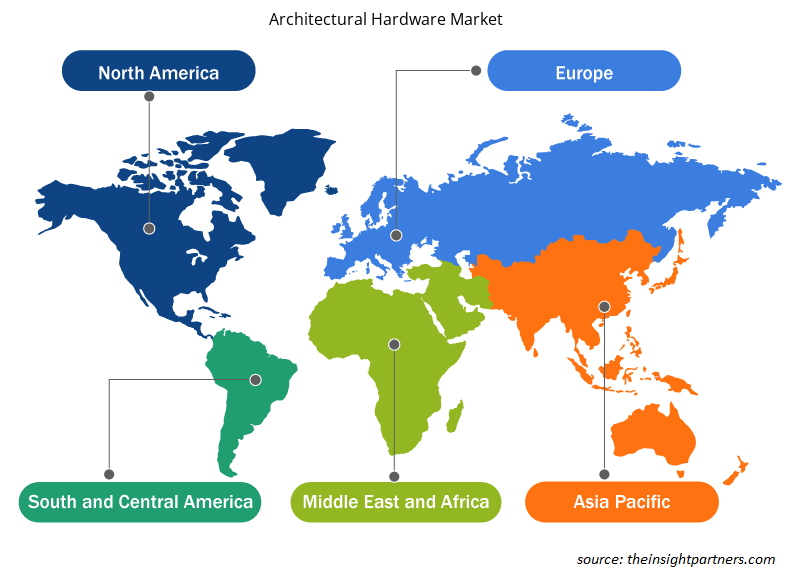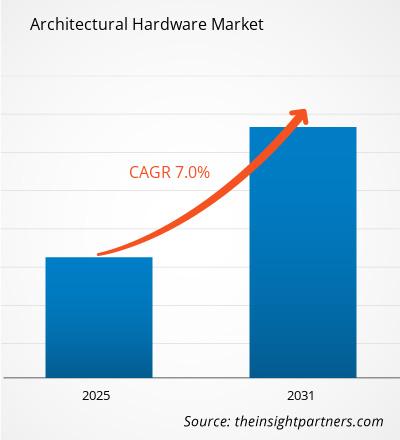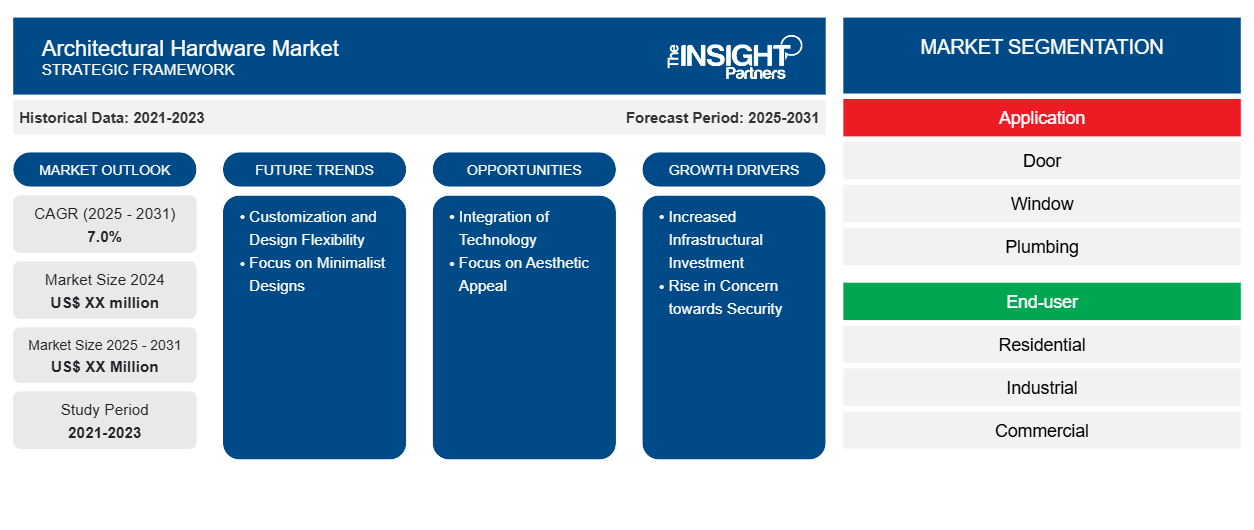من المتوقع أن يسجل سوق الأجهزة المعمارية معدل نمو سنوي مركب بنسبة 7.0٪ من عام 2024 إلى عام 2031، مع توسع حجم السوق من XX مليون دولار أمريكي في عام 2024 إلى XX مليون دولار أمريكي بحلول عام 2031.
تم تقسيم التقرير حسب التطبيق (الأبواب والنوافذ والسباكة والأثاث وغير ذلك). كما يقدم التقرير تحليلاً بناءً على المستخدم النهائي (السكني والصناعي والتجاري). كما تم تقسيم التحليل العالمي إلى مستويات إقليمية ودول رئيسية. ويقدم التقرير القيمة بالدولار الأمريكي للتحليل والقطاعات المذكورة أعلاه.
غرض التقرير
يهدف تقرير سوق الأجهزة المعمارية الصادر عن The Insight Partners إلى وصف المشهد الحالي والنمو المستقبلي وأهم العوامل الدافعة والتحديات والفرص. وسيوفر هذا رؤى لمختلف أصحاب المصلحة في الأعمال التجارية، مثل:
- مزودي/مصنعي التكنولوجيا: لفهم ديناميكيات السوق المتطورة ومعرفة فرص النمو المحتملة، وتمكينهم من اتخاذ قرارات استراتيجية مستنيرة.
- المستثمرون: إجراء تحليل شامل للاتجاهات فيما يتعلق بمعدل نمو السوق، وتوقعات السوق المالية، والفرص المتاحة عبر سلسلة القيمة.
- الهيئات التنظيمية: لتنظيم السياسات ومراقبة الأنشطة في السوق بهدف تقليل الانتهاكات والحفاظ على ثقة المستثمرين ودعم سلامة السوق واستقرارها.
تجزئة سوق الأجهزة المعمارية
طلب
- باب
- نافذة
- السباكة
- أثاث
- آحرون
المستخدم النهائي
- سكني
- صناعي
- تجاري
قم بتخصيص هذا التقرير ليناسب متطلباتك
ستحصل على تخصيص لأي تقرير - مجانًا - بما في ذلك أجزاء من هذا التقرير، أو تحليل على مستوى الدولة، وحزمة بيانات Excel، بالإضافة إلى الاستفادة من العروض والخصومات الرائعة للشركات الناشئة والجامعات
- احصل على أهم اتجاهات السوق الرئيسية لهذا التقرير.ستتضمن هذه العينة المجانية تحليلاً للبيانات، بدءًا من اتجاهات السوق وحتى التقديرات والتوقعات.
محركات نمو سوق الأجهزة المعمارية
- زيادة الاستثمار في البنية الأساسية: تشمل العوامل الأخرى البارزة التي تدفع سوق الأجهزة المعمارية زيادة الاستثمارات في البنية الأساسية. تقوم الحكومات والقطاع الخاص باستثمارات ضخمة في المشاريع السكنية وغير السكنية، مما يعزز الطلب على مجموعة متنوعة من أنواع منتجات الأجهزة المعمارية مثل الأبواب والنوافذ وتجهيزات الأثاث.
- ارتفاع الاهتمام بالأمن: أدى ارتفاع الاهتمام بالأمن والراحة داخل المباني إلى زيادة الطلب على حلول الأجهزة المعمارية الأكثر تطوراً، مثل الأقفال الذكية والأنظمة الآلية. وهذا يشير إلى التفضيل المشترك للمستهلك للمنتجات المعززة تقنياً لتعزيز السلامة وسهولة الاستخدام في التصميمات المعمارية.
الاتجاهات المستقبلية لسوق الأجهزة المعمارية
- التخصيص ومرونة التصميم: التخصيص والتخصيص هما من الاتجاهات الحالية في الحلول المعمارية التي تخلق الفرصة للمصنعين لتلبية متطلبات المستهلكين وفقًا لمتطلباتهم المحددة. تعمل العديد من خيارات الأجهزة القابلة للتخصيص على تحسين رضا العملاء وتوفير ميزة تنافسية للعلامات التجارية في هذه السوق شديدة التنافسية.
- التركيز على التصميمات البسيطة: إن التركيز على التصميمات البسيطة والمعاصرة في الهندسة المعمارية يشكل اتجاهات سوق الأجهزة المعمارية. إن الحلول الأنيقة غير البارزة التي تكمل الجماليات الحديثة تحظى بطلب متزايد، مما يؤثر على تطوير المنتجات.
فرص سوق الأجهزة المعمارية
- دمج التكنولوجيا: يعد دمج التكنولوجيا في المنتجات اتجاهًا رائجًا في سوق الأجهزة المعمارية. هناك تطبيق للتكنولوجيا الذكية المستخدمة في الأقفال وأنظمة الوصول، بالإضافة إلى المواد المتقدمة المستخدمة لإضافة المتانة والوظائف.
- التركيز على الجاذبية الجمالية: أصبح تصميم الأجهزة المعمارية بطريقة تضفي جاذبية جمالية، إلى جانب وظيفتها، مصدر قلق متطور. ويطالب المستهلكون بمزيد من الأجهزة التي تناسب الأسلوب المعماري الحديث، وبالتالي تغيير التصميمات والتشطيبات.
رؤى إقليمية حول سوق الأجهزة المعمارية
لقد قام المحللون في Insight Partners بشرح الاتجاهات والعوامل الإقليمية المؤثرة على سوق الأجهزة المعمارية طوال فترة التوقعات بشكل شامل. يناقش هذا القسم أيضًا قطاعات سوق الأجهزة المعمارية والجغرافيا في جميع أنحاء أمريكا الشمالية وأوروبا ومنطقة آسيا والمحيط الهادئ والشرق الأوسط وأفريقيا وأمريكا الجنوبية والوسطى.

- احصل على البيانات الإقليمية المحددة لسوق الأجهزة المعمارية
نطاق تقرير سوق الأجهزة المعمارية
| سمة التقرير | تفاصيل |
|---|---|
| حجم السوق في عام 2024 | XX مليون دولار أمريكي |
| حجم السوق بحلول عام 2031 | XX مليون دولار أمريكي |
| معدل النمو السنوي المركب العالمي (2025 - 2031) | 7.0% |
| البيانات التاريخية | 2021-2023 |
| فترة التنبؤ | 2025-2031 |
| القطاعات المغطاة | حسب الطلب
|
| المناطق والدول المغطاة | أمريكا الشمالية
|
| قادة السوق وملفات تعريف الشركات الرئيسية |
|
كثافة اللاعبين في سوق الأجهزة المعمارية: فهم تأثيرها على ديناميكيات الأعمال
يشهد سوق الأجهزة المعمارية نموًا سريعًا، مدفوعًا بالطلب المتزايد من المستخدم النهائي بسبب عوامل مثل تفضيلات المستهلك المتطورة والتقدم التكنولوجي والوعي المتزايد بفوائد المنتج. ومع ارتفاع الطلب، تعمل الشركات على توسيع عروضها والابتكار لتلبية احتياجات المستهلكين والاستفادة من الاتجاهات الناشئة، مما يؤدي إلى زيادة نمو السوق.
تشير كثافة اللاعبين في السوق إلى توزيع الشركات أو المؤسسات العاملة في سوق أو صناعة معينة. وهي تشير إلى عدد المنافسين (اللاعبين في السوق) الموجودين في مساحة سوق معينة نسبة إلى حجمها أو قيمتها السوقية الإجمالية.
الشركات الرئيسية العاملة في سوق الأجهزة المعمارية هي:
- شركة اليجيون المحدودة
- أسا أبلوي
- شركة بوهل المحدودة
- شركة سي آر إتش بي إل سي
- جودريج وبويس
إخلاء المسؤولية : الشركات المذكورة أعلاه ليست مرتبة بأي ترتيب معين.

- احصل على نظرة عامة على أهم اللاعبين الرئيسيين في سوق الأجهزة المعمارية
نقاط البيع الرئيسية
- التغطية الشاملة: يغطي التقرير بشكل شامل تحليل المنتجات والخدمات والأنواع والمستخدمين النهائيين لسوق الأجهزة المعمارية، مما يوفر صورة شاملة.
- تحليل الخبراء: تم تجميع التقرير على أساس الفهم العميق لخبراء الصناعة والمحللين.
- معلومات محدثة: يضمن التقرير أهمية الأعمال التجارية بسبب تغطيته للمعلومات الحديثة واتجاهات البيانات.
- خيارات التخصيص: يمكن تخصيص هذا التقرير لتلبية متطلبات العملاء المحددة وبما يتناسب مع استراتيجيات العمل بشكل مناسب.
وبالتالي، يمكن أن يساعد تقرير البحث حول سوق الأجهزة المعمارية في تمهيد الطريق لفك شفرة وفهم سيناريو الصناعة وآفاق النمو. ورغم وجود بعض المخاوف المشروعة، فإن الفوائد الإجمالية لهذا التقرير تميل إلى التفوق على العيوب.
- التحليل التاريخي (سنتان)، سنة الأساس، التوقعات (7 سنوات) مع معدل النمو السنوي المركب
- تحليل PEST و SWOT
- حجم السوق والقيمة / الحجم - عالمي، إقليمي، بلد
- الصناعة والمنافسة
- مجموعة بيانات إكسل
التقارير الحديثة
شهادات العملاء
سبب الشراء
- اتخاذ قرارات مدروسة
- فهم ديناميكيات السوق
- تحليل المنافسة
- رؤى العملاء
- توقعات السوق
- تخفيف المخاطر
- التخطيط الاستراتيجي
- مبررات الاستثمار
- تحديد الأسواق الناشئة
- تحسين استراتيجيات التسويق
- تعزيز الكفاءة التشغيلية
- مواكبة التوجهات التنظيمية





















 احصل على عينة مجانية ل - سوق المعدات المعمارية
احصل على عينة مجانية ل - سوق المعدات المعمارية